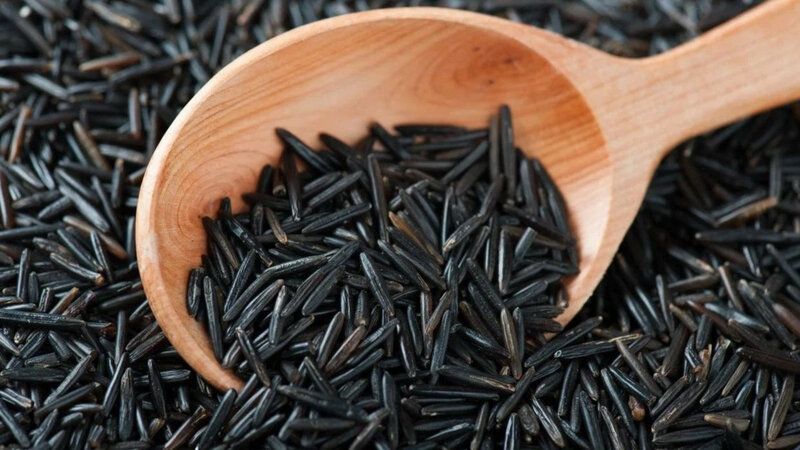Benefits Of Black Rice: The Incredible Forbidden Rice
Black rice, also known as forbidden rice, is a type of rice that has gained popularity in recent years due to its unique characteristics and health benefits. It is a variety of rice that is different from the commonly consumed white and brown rice varieties.
In recent years, black rice has gained recognition as a nutritious alternative to white rice and a versatile ingredient in various culinary traditions. Its unique flavor, striking appearance, and health benefits have made it a favorite among food enthusiasts and those seeking to add more diversity to their diets.
Origins Of Black Rice
Historically, black rice was highly prized in ancient China, and it was even considered a luxury food reserved for the emperors and nobility. The name “forbidden rice” originated from the fact that it was exclusively eaten by the ruling class, and ordinary people were forbidden from consuming it.
Black rice, also known as venere rice, is an exotic rice variety originating from China. In the past, its consumption was limited to the nobility, and it was forbidden for the poor, earning it the name “forbidden rice.”
One of the distinctive features of black rice is its color, which is dark and rich. Additionally, it possesses a delightful aroma reminiscent of nuts. The dark hue of black rice is attributed to its high content of anthocyanins, which are antioxidants of the beta-carotenoid type found in fruits like blueberries. When cooked, black rice transforms into even darker tones, reinforcing its name.
Nutritional Value Of Black Rice
Black rice, also known as forbidden rice, offers a range of nutritional benefits that set it apart from other rice varieties. Here is an overview of the nutritional value of black rice:
1. Fiber: Black rice is a good source of dietary fiber. It contains both soluble and insoluble fiber, which aids in digestion, promotes bowel regularity and can contribute to a feeling of fullness.
2. Antioxidants: One of the most notable characteristics of black rice is its high antioxidant content. The dark color of black rice is due to the presence of anthocyanins, which are potent antioxidants. These antioxidants help protect the body against oxidative stress, reduce inflammation, and may have potential health benefits, including reducing the risk of chronic diseases.
3. Protein: Black rice contains a moderate amount of protein compared to other rice varieties. While it is not as high in protein as certain legumes or animal-based sources, it can still contribute to your overall protein intake.
4. Vitamins and minerals: Black rice is a good source of several essential nutrients. It contains vitamins such as vitamin E and B vitamins, including thiamin, niacin, and vitamin B6. In terms of minerals, black rice provides minerals like iron, magnesium, and zinc.
5. Low in fat: Black rice is naturally low in fat, making it a suitable choice for individuals looking to limit their fat intake.
It’s important to note that the nutritional composition of black rice may vary slightly depending on the specific variety and how it is processed or cooked.
However, overall, black rice offers a nutrient-dense alternative to other rice varieties, thanks to its fiber, antioxidants, vitamins, and minerals. Incorporating black rice into a balanced diet can contribute to overall health and well-being.
One Cup Of Uncooked Rice Contains
A one-cup serving of uncooked black rice typically provides the following nutritional values:
- Calories: Approximately 160 calories.
- Fat: Around 5 grams of fat, which is about 2% of the recommended daily amount.
- Carbohydrates: Approximately 34 grams of carbohydrates, accounting for around 11% of the recommended daily amount.
- Fiber: About 2 grams of dietary fiber, contributing approximately 8% of the recommended daily amount.
- Sugar: Only 1 gram of sugar.
- Protein: Around 5 grams of protein.
These values may vary slightly depending on the specific type of black rice and its preparation. Nonetheless, black rice is generally considered a nutrient-rich food, offering a balance of macronutrients and a significant amount of dietary fiber.
Benefits Of Black Rice
Black rice, also known as forbidden rice, offers a range of benefits due to its unique nutritional profile. Let’s expand on the ten benefits of black rice:
1. High in antioxidants: Black rice contains a higher level of antioxidants compared to other rice varieties. Anthocyanins, the antioxidants responsible for their dark color, help protect the body from oxidative stress, which can lead to various chronic diseases.
2. Promotes heart health: The antioxidants and fiber in black rice contribute to cardiovascular health. They help reduce cholesterol levels, maintain healthy blood pressure, and prevent the oxidation of LDL (bad) cholesterol, which is crucial for preventing heart disease.
3. Supports digestive health: The fiber content in black rice aids in digestion by promoting regular bowel movements, preventing constipation, and supporting the growth of beneficial gut bacteria. This can contribute to a healthy digestive system.
4. Blood sugar regulation: Black rice has a lower glycemic index compared to white rice, meaning it causes a slower and steadier rise in blood sugar levels. This property makes it an excellent choice for individuals managing diabetes or those seeking to control their blood sugar levels.
5. Weight management: The fiber content in black rice provides a feeling of fullness, which can help control appetite and reduce overall calorie intake. This can support weight management efforts.
6. Nutrient-dense: Black rice is packed with essential nutrients such as vitamins (including vitamin E and B vitamins) and minerals (like iron and magnesium). These nutrients are vital for maintaining overall health and well-being.
7. Supports healthy aging: The antioxidants found in black rice play a role in reducing the risk of age-related diseases. They help protect against cognitive decline, certain cancers, and cardiovascular conditions, contributing to healthy aging.
8. Anti-inflammatory properties: The antioxidants in black rice possess anti-inflammatory properties that help combat inflammation in the body. Chronic inflammation is associated with various diseases, including arthritis, obesity, and certain types of cancer.
9. Gluten-free alternative: Black rice is naturally gluten-free, making it a suitable choice for individuals with gluten sensitivities or those following a gluten-free diet. It can be enjoyed as a staple grain without triggering any gluten-related issues.
10. Culinary versatility: Black rice offers culinary versatility, adding a unique flavor, texture, and visual appeal to a wide range of dishes. It can be used in both sweet and savory recipes, such as salads, stir-fries, rice bowls, desserts, and more, making it an exciting ingredient to experiment with in the kitchen.
Incorporating black rice into your diet can provide these benefits while adding variety and nutritional value to your meals.
Side Effects of Black Rice
Black rice is generally safe to consume and does not have any significant side effects when consumed in moderation. However, there are a few considerations to keep in mind:
1. Allergies: Some individuals may have allergies or sensitivities to certain grains, including black rice. If you have a known allergy or sensitivity to rice, it is best to avoid black rice or consult with a healthcare professional before consuming it.
2. Digestive issues: Black rice is high in fiber, which is generally beneficial for digestion. However, for some people who are not accustomed to a high-fiber diet, consuming large amounts of black rice or suddenly increasing fiber intake may lead to temporary digestive discomforts, such as bloating, gas, or changes in bowel movements. It is advisable to gradually increase fiber intake and drink plenty of water to help prevent any potential digestive issues.
3. Phytic acid content: Like other whole grains, black rice contains phytic acid, which is a naturally occurring compound that can interfere with the absorption of certain minerals, such as iron and zinc. However, the impact of phytic acid on mineral absorption can be mitigated by soaking, fermenting, or cooking the rice properly.
4. Caloric content: Black rice, like other rice varieties, is relatively calorie-dense. While it can be part of a healthy diet, consuming excessive amounts without considering overall calorie intake may contribute to weight gain.
It’s important to note that individual sensitivities and reactions can vary. If you have any specific concerns or medical conditions, it is advisable to consult with a healthcare professional or registered dietitian before incorporating black rice into your diet. They can provide personalized guidance based on your individual needs and health status.
How To Cook Black Rice?
Cooking black rice requires a slightly different approach compared to white or brown rice due to its unique characteristics. Here’s a basic method for cooking black rice:
1. Rinse the rice: Start by rinsing the black rice under cold water to remove any impurities or excess starch. Use a fine-mesh strainer or sieve for this step.
2. Soak the rice (optional): While not necessary, soaking black rice for 1-2 hours before cooking can help reduce the cooking time and improve its texture. If you choose to soak, drain the rice after soaking.
3. Ratio of rice to water: The general ratio for cooking black rice is 1 cup of rice to 2 cups of water. This ratio can be adjusted slightly based on personal preference or the specific variety of black rice being used.
4. Cooking on the stovetop: In a saucepan, add the rinsed and drained black rice along with the appropriate amount of water. Bring the mixture to a boil over medium-high heat. Once boiling, reduce the heat to low, cover the saucepan with a lid, and let it simmer for about 30-40 minutes. Check the rice towards the end of the cooking time to ensure it is tender and cooked through.
5. Cooking in a rice cooker: Alternatively, you can cook black rice in a rice cooker by following the manufacturer’s instructions. Simply add the rinsed rice and the recommended amount of water to the rice cooker, close the lid, and select the appropriate setting for cooking.
6. Resting and fluffing: Once the black rice is cooked, remove it from the heat and let it rest, covered, for about 5-10 minutes. This resting period allows the rice to steam and become fluffier. After resting, use a fork to gently fluff the rice to separate the grains.
Black rice can be enjoyed as a side dish, added to salads or stir-fries, or incorporated into various recipes according to your preference. Experiment with different seasonings, herbs, or sauces to enhance their flavor and complement your dishes.
References
- https://en.wikipedia.org/wiki/Black_rice
- www.webmd.com/diet/health-benefits-black-rice


























